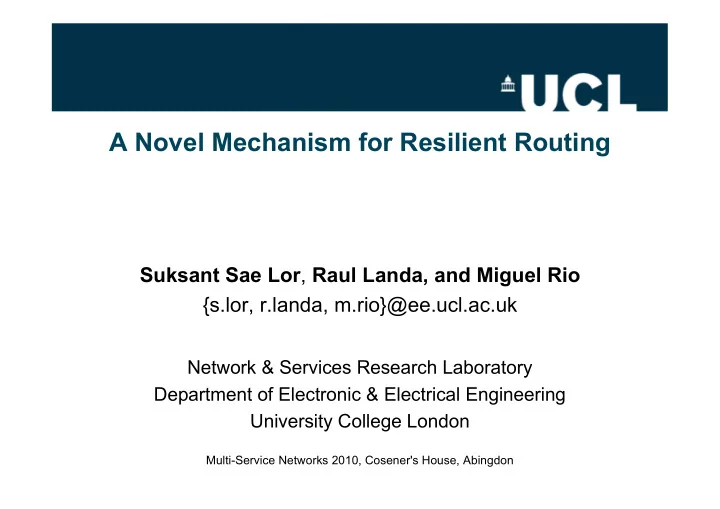

A Novel Mechanism for Resilient Routing Suksant Sae Lor , Raul Landa, and Miguel Rio {s.lor, r.landa, m.rio}@ee.ucl.ac.uk Network & Services Research Laboratory Department of Electronic & Electrical Engineering University College London Multi-Service Networks 2010, Cosener's House, Abingdon
Introduction & Motivation • Network failures cause packet losses S D • Re-convergence is not fast enough Speed of convergence: Sensitive applications can’t tolerate this! Packet loss rates: • Existing approaches are not universal Single failures? Shared-risk link group? Multiple failures? Node failures? Dual failures? Link failures?
Existing Resilient Mechanisms • Loop-Free Alternates (LFAs) • Not-via addresses • Multiple Routing Configurations (MRC) • Failure-Insensitive Routing (FIR) • SafeGuard
Existing Resilient Mechanisms • Loop-Free Alternates (LFAs) • Not-via addresses Aim to solve only • Multiple Routing Configurations (MRC) “SINGLE FAILURES”! • Failure-Insensitive Routing (FIR) • SafeGuard • Failure-Carrying Packets (FCP)
Existing Resilient Mechanisms • Loop-Free Alternates (LFAs) • Not-via addresses Aim to solve only • Multiple Routing Configurations (MRC) “SINGLE FAILURES”! • Failure-Insensitive Routing (FIR) • SafeGuard Large overheads • Failure-Carrying Packets (FCP) Difficult to implement
Packet Re-cycling (PR) Overview • Handles any number of failures • Pre-computed paths; hence, fast re-route • No major modifications on current routing • Minimal packet/memory overheads • Shortest path routing under failure-free scenario • Routing & cycle following in case of failures
Cellular Graph Embeddings • Draw a network graph, G on a closed surface, S A D G B E H C F
Cellular Graph Embeddings • Minimum genus embedding: cellular cycle system A D G C1 C3 B E H C2 C4 C F
Cellular Graph Embeddings • Each link is included in exactly 2 cycles A D G Complementary Main cycle C1 C3 Cycle B E H C2 C4 C F
Packet Re-cycling (PR) Routing & Cycle Following • Routing using normal routing table (no failures) A D G C1 C3 B E H C2 C4 C F
Packet Re-cycling (PR) Routing & Cycle Following • Cycle following when a failure is encountered A D G C1 C3 B E H C2 C4 C F
Packet Re-cycling (PR) Routing & Cycle Following • Only PR bit (1 bit) is used to handle single failures A D G C1 C3 B E H C2 C4 C F
Packet Re-cycling (PR) Routing & Cycle Following • Forwarding loop without termination condition A D G C1 C3 B E H C2 C4 C F
Packet Re-cycling (PR) Cycle Following Termination Condition • Terminates only if it is closer to the destination! Node No. of hops to F A D G A 7 B 2 C1 C3 C 1 B E H D 6 E 3 C2 C4 G 5 C F H 4
Packet Re-cycling (PR) Cycle Following Termination Condition • G detects a failure, it performs cycle following From No. of hops to F A D G A 7 B 2 C1 C3 C 1 B E H D 6 E 3 C2 C4 G 5 C F H 4
Packet Re-cycling (PR) Cycle Following Termination Condition • A detects a failure, its performs cycle following From No. of hops to F A D G A 7 B 2 C1 C3 C 1 B E H D 6 E 3 C2 C4 G 5 C F H 4
Packet Re-cycling (PR) Cycle Following Termination Condition • B detects a failure, it performs routing From No. of hops to F A D G A 7 B 2 C1 C3 C 1 B E H D 6 E 3 C2 C4 G 5 C F H 4
Benefits • Minimal overheads while providing full protection: – Packet header • 1 bit for single failure cases • Order of log 2 (d) , where d is the network diameter • For d � 7 , pool 2 DSCP can be used – Memory • Additional column in the routing table • Cycle following tables (no. of interfaces x 3)
Incurred Stretch • Stretch: cost(re-routing path) / cost(shortest path) Abilene with 1 failure cases Abilene with 4 failure cases (worst-case scenarios)
Conclusion • Resilience is important • Some applications cannot tolerate losses • Most mechanisms handle only single failure cases • PR provides a full-failure protection with minimal overheads
Thank you! Q & A
Recommend
More recommend